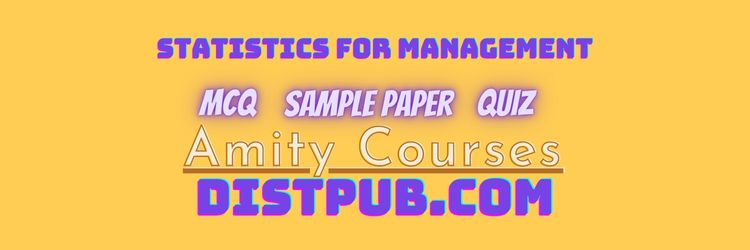Looking for comprehensive Statistics for Management MCQs with answers and sample papers for Amity exams? Look no further! Our collection of MCQs and quizzes will help you prepare for your exams and boost your confidence. With our extensive range of MCQs and sample papers, you can test your knowledge and practice for your exams with ease. Explore our Statistics for Management MCQs with answer, exam quiz, and sample paper for Amity today!
Statistics for Management mcq practice set with answer
- Statistics for Management amity mcq set 1
- Statistics for Management amity mcq set 2
- Statistics for Management amity mcq set 3
- Statistics for Management amity mcq set 4
- Statistics for Management amity mcq set 5
Exam quiz for Statistics for Management
coming soon
Amity Syllabus of Statistics for Management
Module I Introduction
- Statistical thinking and analysis ;
- Statistics defined; Types of statistical methods – Descriptive and inferential statistics; Importance and scope of statistics ;.
- Scales of measurement;
- Basic statistical concepts: population and sample.
Tabular and Graphical Descriptive Techniques using MS Excel: - Bar chart, Pie Chart, Histogram, Frequency Polygon, Ogive, Pareto Chart.
- Stem-and-leaf display, Cross tabulations, Scatter plot and Trend line.
Numerical Measures - Arithmetic Mean, Median and Mode.
- Partition Values- Quartiles, and percentiles.
- Measures of Variability: Range, IQR; Variance, Standard Deviation, Coefficient of variation.
- Use of MS Excel for Numerical Measures
Module II Probability and Probability Distributions
- Types of events and Algebra of events. Assigning probability to events;
- Joint, Marginal and Conditional Probability.
- Probability Rules; complement Rule, Multiplication Rule, Addition Rule, Bayes¡¦
Theorem.
Probability Distributions: - Mean or Expected value of random variable.
- Variance and Standard Deviation of random variables.
- Binomial Probability Distribution, Poisson Probability Distribution and Normal
Probability Distribution. - Using MS Excel for computation of Binomial, Poisson and Normal probabilities.
Module III Sampling, Sampling Distribution and Estimation
- Sampling: Basic Concepts, Types of Sampling and Non-Sampling Errors and
Precautions, - Central Limit Theorem,
- Sampling Distribution of the mean, Sampling distribution of proportion.
- Estimation: Types Estimates, Using z Statistic for estimating population mean,
- Confidence interval for estimating population mean when population SD is unknown,
- Estimating population mean using t Statistic (small sample case), and Confidence interval estimation for population proportion.
- Using MS Excel for confidence interval construction.
Module IV Hypothesis Testing
Fundamental Concepts of Hypothesis Testing:
- Developing null and alternate hypothesis,
- Hypothesis testing procedure, the critical value of the test statistic, regions and rejection and non-rejection,
- Type I error and Type II error,
- Level of significance,
- The confidence coefficient, The power of a test,
- The p-value approach to hypothesis testing.
Inference about a Population: - For single population mean using z-statistic, for single population mean using t-statistic, hypothesis testing for population proportion.
Inference about Comparing Two Populations: - Inference about the difference between two population means ‘
- Independent samples and Matched Samples,
- Inference about the difference between two population proportions, Inference about the ratio of two population variances.
Analysis of Variance (Analysis and Interpretation of MS Excel Output only): - Testing for equality of k- population means,
Chi-Squared Tests: - Chi-squared goodness of fit test for mean, and test of independence. Using MS Excel for
Chi-squared test.
Module V Forecasting Techniques
- Measures of Linear Relationship: covariance, coefficient of correlation.
- Regression: Model, Estimating the coefficient using least squares method. Assessing the
Model (Analysis and Interpretation of Excel Output only); - Standard Error of Estimate, Coefficient of determination,
Time Series Analysis: - Variation in Time Series, Numerical application of trend analysis only.
Total Views: 72

